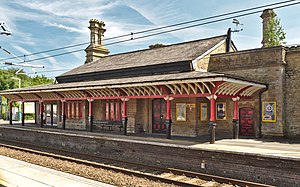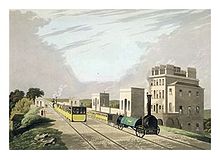| Earlestown[REDACTED] | |||||
|---|---|---|---|---|---|
 Platform at historic Earlestown station Platform at historic Earlestown station | |||||
| General information | |||||
| Location | Earlestown, Newton-le-Willows, St Helens England | ||||
| Coordinates | 53°27′04″N 2°38′17″W / 53.451°N 2.638°W / 53.451; -2.638 | ||||
| Grid reference | SJ578951 | ||||
| Managed by | Northern Trains | ||||
| Transit authority | Merseytravel | ||||
| Platforms | 5 | ||||
| Other information | |||||
| Station code | ERL | ||||
| Fare zone | A1 | ||||
| Classification | DfT category E | ||||
| History | |||||
| Original company | Liverpool and Manchester Railway | ||||
| Pre-grouping | London and North Western Railway | ||||
| Post-grouping | London, Midland and Scottish Railway | ||||
| Key dates | |||||
| 17 September 1830 | Opened | ||||
| November 1861 | Renamed Earlestown Junction | ||||
| 5 June 1950 | Renamed Earlestown | ||||
| Passengers | |||||
| 2019/20 | |||||
| Interchange | | ||||
| 2020/21 | |||||
| Interchange | | ||||
| 2021/22 | |||||
| Interchange | | ||||
| 2022/23 | |||||
| Interchange | | ||||
| 2023/24 | |||||
| Interchange | | ||||
| |||||
Earlestown railway station is a railway station in Earlestown, Merseyside, England, and one of the few "triangular" stations in Britain.
History
| This section needs additional citations for verification. Please help improve this article by adding citations to reliable sources in this section. Unsourced material may be challenged and removed. (March 2024) (Learn how and when to remove this message) |
Early history
The station lies on the former Liverpool and Manchester Railway, which was opened on 15 September 1830. The station opened with the commencement of passenger services on 17 September. The station was not originally called Earlestown; it was listed as Viaduct, Newton Junction and Warrington Junction in timetables during its early years of operation. By 1861, it was known as Earlestown Junction until 5 June 1950, when the 'Junction' suffix was dropped.
On 25 July 1831 the Warrington and Newton Railway was opened for public use, making a junction at a point in the township of Newton, facing in the direction of Liverpool.
The surviving Earlestown station buildings were constructed around 1835 on the original site, at the point of intersection of these two early railways, incidentally forming the first steam railway junction, which was given the name Newton Junction.
The junction had a very tight curvature and this caused problems. Train travelling on the curves were restricted to a slow maximum speed. The original building now forms the (currently unused) waiting room of Earlestown Station.
The Grand Junction Railway (GJR) absorbed the Warrington and Newton company as of 31 December 1834 and from the GJR's completion of their trunk line from Birmingham on 4 July 1837 used it to access the Liverpool and Manchester line. A new "Curve" was built at Newton Junction so that trains could run towards Manchester; this gave the station a triangular formation with six platforms. To complicate matters, there was also a branch line from Richard Evans's collieries at Haydock which had a curve to join the L & M in the Manchester direction and passed through the triangle to join the Warrington and Newton line.
The method of operation involved the despatch of a Grand Junction train from both Liverpool and Manchester to meet at Earlestown. These were joined together and continued as one train to Birmingham. Both portions conveyed through carriages after 1839 to London. The Grand Junction trains arriving from Birmingham were usually split at Warrington (Bank Quay) and passed through Earlestown as separate Liverpool and Manchester trains.
An area between the station and the "Nine Arches" viaduct was selected in 1833 by Messrs Jones, Turner and Evans as the site of their Viaduct Locomotive Works. In 1853, the London and North Western Railway took a lease on the premises and thus established the company's carriage and wagon works, and the area developed into something of a 'company town' which, after the construction of company houses, was given the nickname "Earle's Town" after Hardman Earle, a director of the company and its predecessors, the Liverpool & Manchester and Grand Junction Railways. The name has stuck, despite it being corrupted to its present version and never having been an actual town.
Later history
The London and North Western Railway later operated their main line service to the Scottish border by way of Earlestown and Parkside, utilising a short section of the old Liverpool and Manchester line. This inconvenient routing was eliminated by the construction of the Golborne cut-off, a direct connection avoiding Earlestown. The original route, on the eastern section of the triangle, was electrified at 25 kV 50 Hz AC as part of the West Coast Main Line electrification, since it was then used by a few trains stopping at Earlestown.
In the Beeching Report of 1963, Earlestown was listed as one of the stations to be closed, but it remained open along with other stations between Liverpool and Manchester that had also been listed such as Huyton and Edge Hill. However, direct trains to St Helens Shaw Street via St Helens Junction were withdrawn in 1964.
The remaining parts of the station were electrified as part of the North West electrification, which was announced in July 2009. This project saw the original West Coast Main Line electrification joined to the Manchester to Liverpool electrification at the east and south sides of Earlestown station. This electrification work was completed in February 2015.
At present, there are frequent services to Liverpool Lime Street, Manchester Victoria, Manchester Airport, Warrington Bank Quay, Chester and then via the North Wales Coast Line to Llandudno.
Scheduled electrically-operated passenger services commenced from the station during March 2015, when the Liverpool Lime Street to Manchester Airport service converted from diesel to electric traction. Previously, despite the long-standing electrification of part of the station, no electrically operated passenger services were scheduled to call at Earlestown.
Historical status
| This section may be confusing or unclear to readers. In particular, it is odd to have this section in addition to a section already named "History". Please help clarify the section. There might be a discussion about this on the talk page. (September 2022) (Learn how and when to remove this message) |
| Newton Junction | ||||||||||||||||||||||||||||||||||||||||||||||||||||||||||||||||||||||||||||||||||||||||
|---|---|---|---|---|---|---|---|---|---|---|---|---|---|---|---|---|---|---|---|---|---|---|---|---|---|---|---|---|---|---|---|---|---|---|---|---|---|---|---|---|---|---|---|---|---|---|---|---|---|---|---|---|---|---|---|---|---|---|---|---|---|---|---|---|---|---|---|---|---|---|---|---|---|---|---|---|---|---|---|---|---|---|---|---|---|---|---|---|
| Legend | ||||||||||||||||||||||||||||||||||||||||||||||||||||||||||||||||||||||||||||||||||||||||
| 1846–47 | ||||||||||||||||||||||||||||||||||||||||||||||||||||||||||||||||||||||||||||||||||||||||
| ||||||||||||||||||||||||||||||||||||||||||||||||||||||||||||||||||||||||||||||||||||||||
| 1891 | ||||||||||||||||||||||||||||||||||||||||||||||||||||||||||||||||||||||||||||||||||||||||
| ||||||||||||||||||||||||||||||||||||||||||||||||||||||||||||||||||||||||||||||||||||||||
| 1908 | ||||||||||||||||||||||||||||||||||||||||||||||||||||||||||||||||||||||||||||||||||||||||
| ||||||||||||||||||||||||||||||||||||||||||||||||||||||||||||||||||||||||||||||||||||||||

The triangular track layout at Earlestown (originally named Newton Junction) represents the oldest junction in the world between two passenger railways, in the form of the first "stationary turntable" or wye ever constructed. Nearby on the line towards Liverpool is the Sankey Viaduct, the first mainline railway viaduct which crosses the Sankey Canal: that means that one of the earliest passenger railways crosses the first canal of the industrial revolution.
Earlestown is one of two triangular railway stations left in the UK, the other being Shipley in West Yorkshire
The waiting room on the Liverpool-bound platform is the oldest station building in the world still in passenger service, although this is now limited to providing shelter from the rain under its canopy. The building is currently derelict, with tickets being sold in a more recent structure on the opposite side of the line.
Facilities
The ticket office is staffed for the duration of service here each day (06:00 to midnight weekdays and Saturdays, 08:30 to midnight Sundays). Digital information screens, timetable poster boards and automatic announcements provide train running information. All platforms have either shelters or canopies. Only platforms 1 and 5 have step-free access, as the others are reached via the stepped footbridge between platforms 1 and 2.
Platform layout
- Platform 1 for services to Manchester Victoria and Crewe (via Manchester Airport), via Newton-le-Willows; operated by Northern Trains
- Platform 2 for services to Liverpool Lime Street, via St Helens Junction; operated by Northern Trains
- Platform 3 for service towards Liverpool Lime Street (bi-directional platform); operated by Northern Trains single daily service only
- Platform 4 for services to Manchester Piccadilly and Manchester Airport, via Newton-le-Willows; operated by Transport for Wales and to Leeds via Manchester Victoria operated by Northern Trains
- Platform 5 for services to Chester and Llandudno, via Warrington Bank Quay; operated by Transport for Wales; Northern Trains also now run to Chester from this platform
Services
Earlestown sees services heading to many destinations.
Platform 1: There is an hourly service to Manchester Airport, operated by Northern.
Platform 2: There is an hourly service to Liverpool Lime Street, operated by Northern.
Platform 3: There is only one train per day from this platform. There is an evening service to from Ellesmere Port to Liverpool Lime Street, operated by Northern.
Platform 4: There is an hourly service to Manchester Airport, which operated semi-fast and is operated by TfW. There is an hourly service to Leeds via Manchester Victoria, Halifax and Bradford Interchange - operated by Northern.
Platform 5: There is an hourly service to Chester, operated by Northern. There is an hourly service to Chester, with many services extending to Llandudno, Bangor or Holyhead, operated by TfW.
See also
References
- Quick, Michael (2023) . Railway passenger stations in Great Britain: a chronology (PDF). version 5.05. Railway & Canal Historical Society. p. 175.
- Admin. "Earlestown Station | Immediate Significance". Rainhill Trials. Retrieved 5 November 2019.
- "Earlestown Station". Newton-le-Willows Heritage Trail. Retrieved 5 November 2019.
- Earlestown station facilities National Rail Enquiries; Retrieved 22 December 2016
- Table 85 National Rail timetable, December 2023
- Table 77 National Rail timetable, December 2023
Bibliography
- Butt, R. V. J. (October 1995). The Directory of Railway Stations: details every public and private passenger station, halt, platform and stopping place, past and present (1st ed.). Sparkford: Patrick Stephens Ltd. ISBN 978-1-85260-508-7. OCLC 60251199. OL 11956311M.
- Liverpool & Manchester Railway 1830-1980, Frank Ferneyhough, Book Club Associates, 1980, (no ISBN)
- Awdry, Christopher (1990). Encyclopaedia of British Railway Companies. Sparkford: Patrick Stephens Ltd. ISBN 1-8526-0049-7. OCLC 19514063. CN 8983.
External links
| Merseytravel City Line stations | |
|---|---|
| Wigan | |
| Newton-le-Willows | |
| Warrington | |